Beyond Democracy: Mobilizing BIPOC Voters in the South – A Narrative Guide

INTRODUCTION
The South is not a problem to be solved but a promise to be fulfilled. It has been the birthplace of civil rights movements, labor movements, and moral movements. It is where we’ve learned to fight, and it is where we’ve learned to win.
Historically, the South has been characterized by its deep-rooted racial divides. The mobilization of Black voters has been instrumental in challenging systemic inequalities and shaping the political landscape. Activists and politicians emphasize the importance of mobilizing these and other BIPOC communities to advance social justice, economic equity, and political representation. Their participation is crucial for building a more inclusive and representative democracy in the South.
This narrative guide pulls together public opinion research and the insights of partners and allies to provide guidance and tools for telling the story of community, activism, and the importance of protecting our democracy in the South. It is our hope that by creating and pushing out a cohesive narrative about community and activism, we can continue to build on BIPOC Southerners’ legacy of power building to rally for the kinds of policies and approaches we know will result in better communities for everyone living in the region.
background
In 2023, The Opportunity Agenda (TOA) invited 23 individuals whose organizational or primary work is conducted in the U.S. South to join our Beyond Democracy cohort. The primary objective of the Beyond Democracy project is to influence the thinking and motivations of potential and current Southern voters of color by meeting them where their civic interests lie. To complete the first portion of this project – cohort development, insight gathering, and research – TOA collaborated with consultants at Uprise and researchers from Frameshift.
By recruiting cohort participants who are artists and advocates regularly conducting civic engagement work at a grassroots level, our shared research questions and communication strategies were able speak directly to their respective audiences and evoke tones with a greater likelihood of audience resonance. Together, we embarked on research into the motivations of BIPOC Southern voters and what encouraged or prevented their participation in community at a number of levels. Following are our recommendations for encouraging community and civic engagement among these audiences.
THE POWER OF NARRATIVE
History and experience show that to be effective in moving hearts, minds, and policy over the long term, we need to frame messages under strong, values-based narratives that can transform the larger conversation, shift culture, and result in lasting change. Supporting and promoting a narrative in our communications does not mean we all must say the same thing with the same words. Rather, we each can find ways to translate the narrative and its core themes to the audiences we know best through our message development.
building a narrative
Experience and research suggest that successful narratives share a few common elements.
THEY SHOULD:
- Lead with shared values and a clear vision;
- Describe problems, but also point audiences toward clear solutions;
- Be informed by public opinion research, media analysis, communications practice, and collective experience;
- Adapt to key audiences, spokespeople, sub-issues, and circumstances; and
- Support a coherent “drumbeat” of stories, messages, and events—both short and long-term.

To ensure that the Beyond Democracy narrative met these criteria, the development process was guided by consultation with those active in the field of civic engagement and democracy, and original narrative research with Southern voters of color. These formed the strategy for and core pillars of a narrative that we hope will move audiences, reflects the values, and experience of the field, and has a positive impact on the lives of those most affected by the policies we want to protect, improve, or change.
A NARRATIVE FRAMEWORK TO MOBILIZE BIPOC VOTERS IN THE SOUTH
vision
- Broad support for, participation in, and reclamation of democracy in the South;
- Motivated and inspired communities of color who cross the barrier from interest in community involvement to a desire to participate more directly in civic engagement and democracy and;
- Increased support for policies that protect democracy and voting.
values: sample language
COMMUNITY
“We share responsibility for each other, and the strength of our nation depends on the vibrancy and cohesiveness of our communities. We understand that opportunity is not only about personal success but also about our success as a people.”
LEGACY
“We have to build on the legacy of our ancestors by being active participants in the shaping of the world that we leave our children and grandchildren.”
HOPE
“We believe that the impossible is possible. We have a vision of a community and country that values and respects everyone’s rights and where everyone can reach their potential. We will center that vision in everything we do.”
ACTIVISM/PARTICIPATION
“By coming together to share our experiences and ideas, we can form solutions to the many issues facing us. It’s crucial that we join together to make them happen.”
VOICE
“We should all have a say in the decisions that affect us. Our voices must be heard in voting booths, at public forums, and across all media.”
desired narrative
We all have a responsibility to our communities, leaving behind a legacy for future generations. Each of us can make a positive impact, showing that the impossible is possible. By protecting democracy and participating in community efforts, we pave the way for a brighter tomorrow. When we work together, we prove that even the most daunting challenges can be overcome. Let’s join forces and make a difference that echoes through time.
narrative pillars
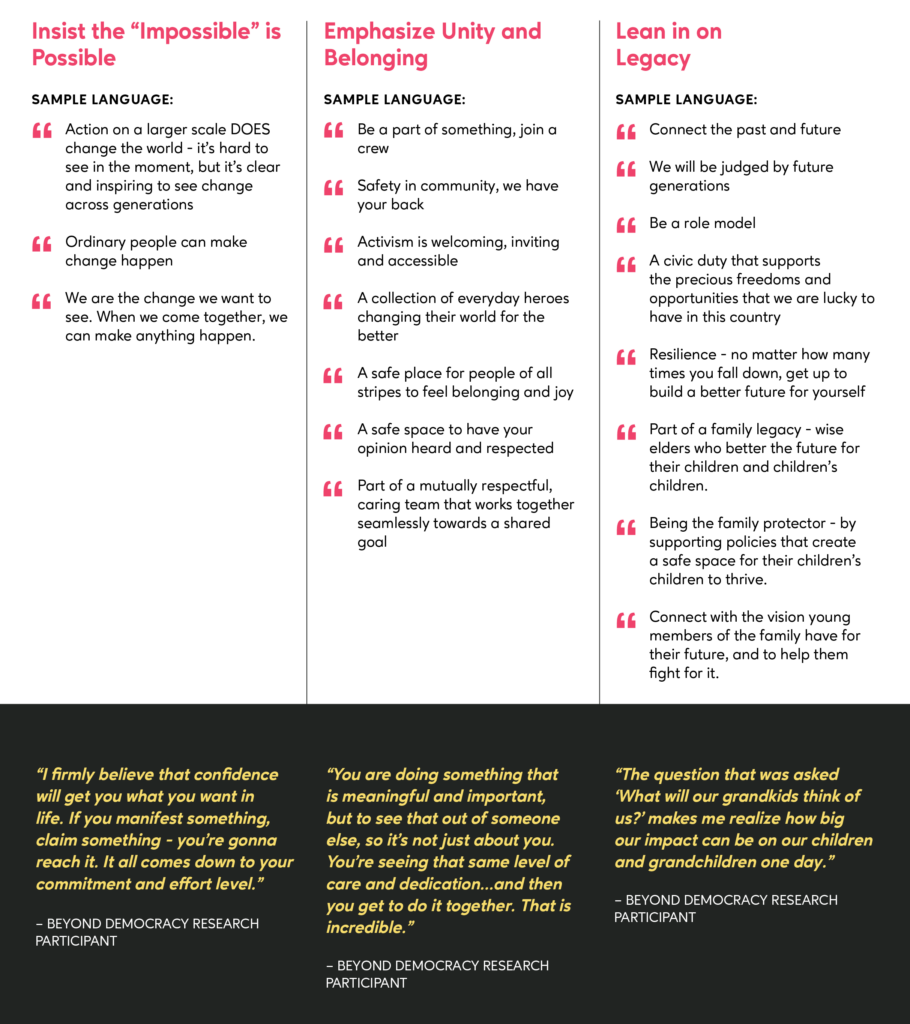
SETTING NARRATIVE GOALS
Once we’ve established the narrative we want to emerge and the narratives that currently prevail – through research and observation – we can start to outline clear narrative goals.
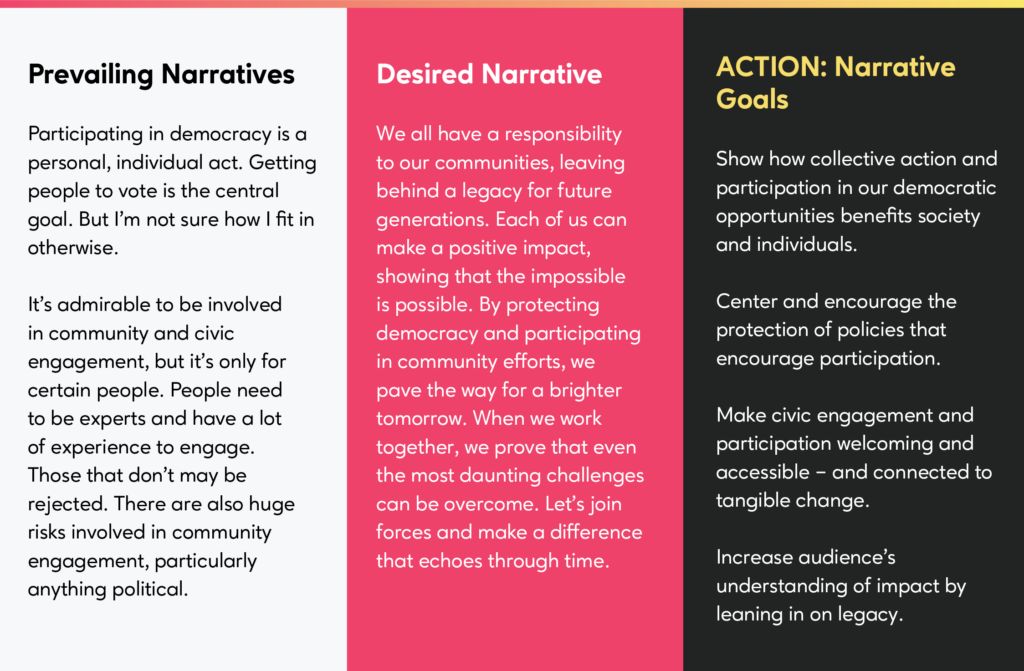
audience considerations
In any communications strategy, knowing the audience you are hoping to influence is crucial. Each message should be tailored to that specific audience’s needs. A narrative can span several audiences, with different language and points using the same general themes. A flexible narrative will be able to inspire messages to motivate our base, expand our constituency, bring along persuadables, and neutralize the opposition’s effect on all of these groups. Rather than spending time and resources trying to change the mind of the opposition or even fighting with them, we should focus on considering how to address any influence they have over audiences in the middle.
Audience Segmentation: Identifying Your Audience
SEGMENTING AUDIENCES
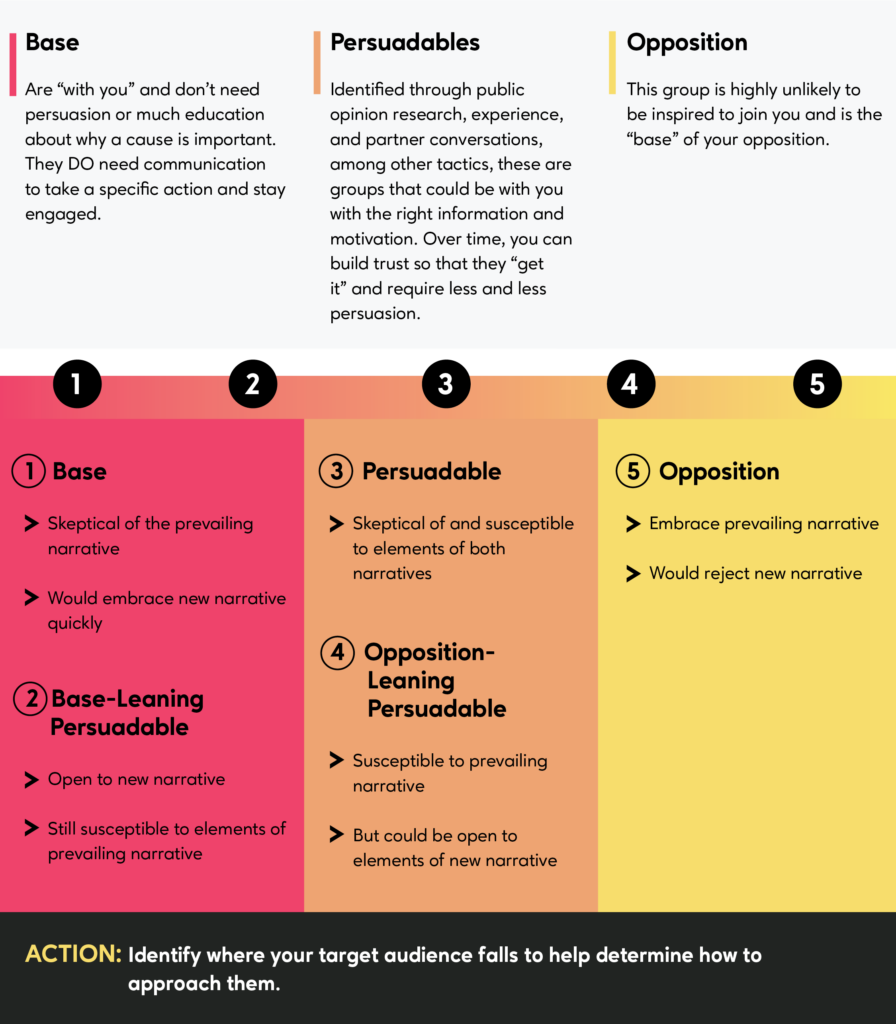
BUILDING A MESSAGE
To introduce people to a new way of thinking about any issue, it’s important to consider the structure of our messages—particularly how they begin.
People think in shortcuts and once we’ve activated a familiar shortcut, they are likely to process all future information through the lens of that shortcut.
If we start with vision and values and fit the importance of the solutions we want into that framework, many audiences will find themselves more open to the rest of our points.
To this end, we suggest you build messages using the following structure:

values and vision
Starting with shared values helps audiences to “hear” our messages more effectively than do dry facts or emotional rhetoric.
COMMUNITY
“We share responsibility for each other, and the strength of our nation depends on the vibrancy and cohesiveness of our communities. We understand that opportunity is not only about personal success but also about our success as a people.”
LEGACY
“We have to build on the legacy of our ancestors by being active participants in the shaping of that world that we leave our children and grandchildren.”
HOPE
“We believe that the impossible is possible. We have a vision of a community and country that values and respects everyone’s rights and where everyone can reach their potential. We will center that vision in everything we do.”
ACTIVISM/PARTICIPATION
“By coming together to share our experiences and ideas, we can form solutions to the many issues facing us. It’s crucial that we join together to make them happen.”
VOICE
“We should all have a say in the decisions that affect us. Our voices must be heard in voting booths, at public forums, and across all media.”
problem
This is the place to pull out statistics or stories that are likely to resonate with the target audience.
- Frame problems as a threat to our vision and values.
- Underscore our connections to one another, and why this problem matters to everyone.
solution
Positive solutions leave people with choices, ideas, and motivation.
- What is the commonsense approach to the problem you have outlined?
- Find ways to frame the solution as both the most commonsense and the most in line with our values.
- Assign responsibility—Who can enact this solution?
action
While the solution points out the overarching policy or program ask, the action is an audience-specific way to spur action.
- What can this specific target audience do? Try to give them something concrete that they can even picture themselves doing: making a phone call or sending an email.
- Steer clear of vague “learn more” messages, when possible.
sample messages
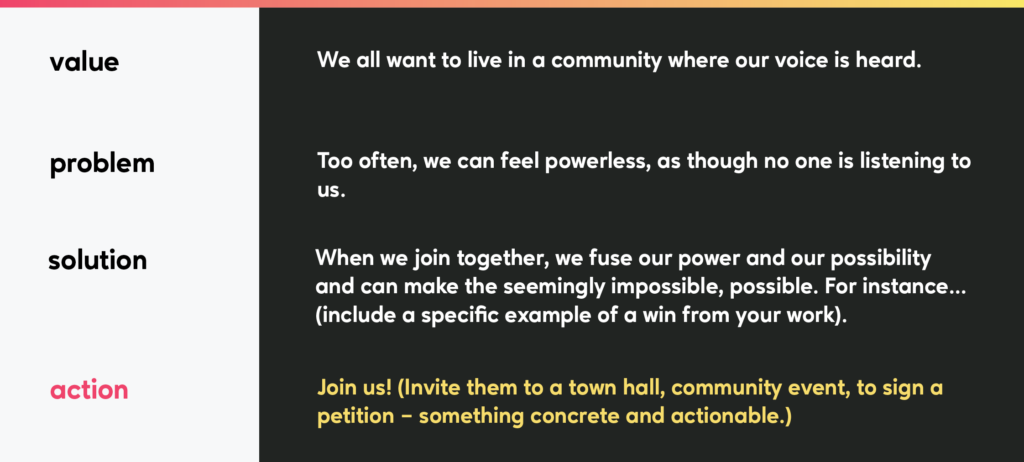
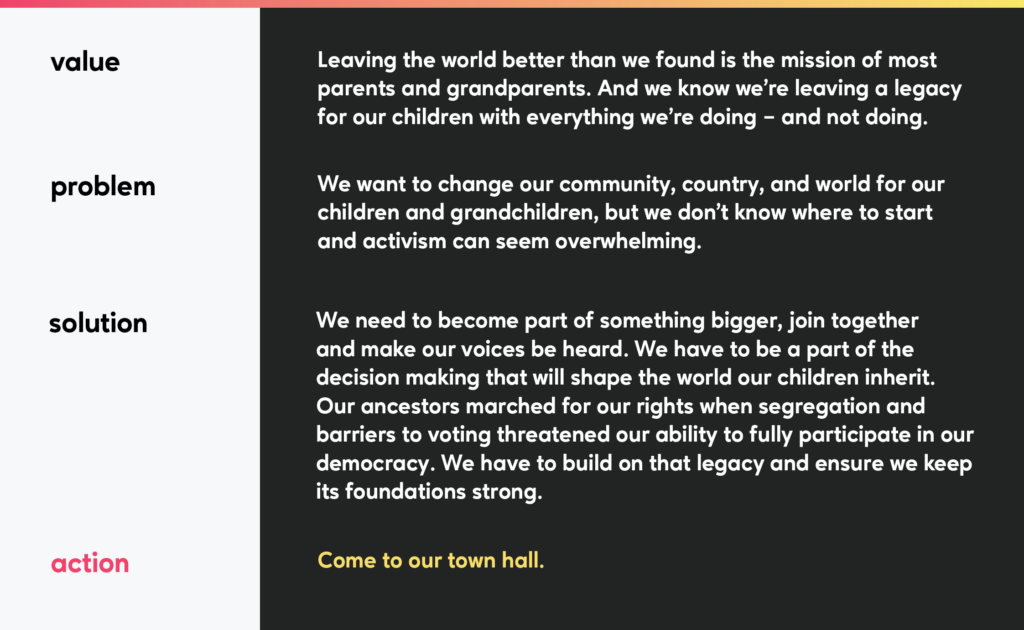
Useful phrases to build narrative-supporting messages, from Frameshift research:
Impossible is Possible
“Action on a larger scale DOES change the world – it’s hard to see in the moment, but it’s clear and inspiring to see change across generations.”
“Every small action – recycling, helping a neighbor – is part of a larger purpose. Political action is about contributing to the greater good and living a meaningful life.”
“You know what it means to be resilient in the face of overwhelming obstacles. Taking a small political action shows that you don’t give up – you keep trying to build a brighter future for yourself and others.”
“When everyone does their part, anything is possible! Political action is not about me, it’s about WE. You can do your small part in politics, and be part of greater change for your kids and their kids.”
Unity and Belonging
“A democratic movement is a safe space to have your opinion heard and respected – be reassured that others want to hear you and there are no right or wrong opinions.”
“You’ve faced your own struggles and have emerged stronger as a result. You can help everyone who is part of the movement feel validated as a mini changemaker.”
“You can be part of a movement that welcomes you, whoever you are – we are all different people, but we belong together – finding joyful moments as we work to make the world a better place.”
“A progressive movement, by definition, is focused on bringing to life new ideas from younger generations – your voice will be valued and welcomed.”
Lean in on Legacy
“Be a part of your family’s legacy – by taking political action, you are the wise elder who betters the future for your children and children’s children.”
“Be your family’s protector by supporting policies that create a safe space for your children and your grandchildren to thrive.”
“Taking political action is a bridge to the younger generation – asking them what they want for their future, and figuring out how you can help fight for it.”
“We’re all grateful for the freedoms and opportunities we have in this country – participating in political action to support those freedoms is a way to fulfill your civic duty.”
Community is not just where we live; it’s who we are. Our strength lies in our relationships, our shared values, and our commitment to each other. When we come together as a community, we have the power to create positive change and shape our collective destiny.

